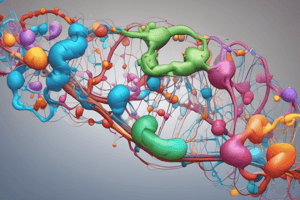Podcast
Questions and Answers
In prokaryotic RNA synthesis, which enzyme recognizes the promoter and transcribes only one DNA strand?
In prokaryotic RNA synthesis, which enzyme recognizes the promoter and transcribes only one DNA strand?
- Topoisomerase
- Sigma factor
- RNA polymerase (correct)
- DNA polymerase
What is the role of topoisomerases in prokaryotic RNA synthesis?
What is the role of topoisomerases in prokaryotic RNA synthesis?
- Terminate transcription
- Promote mRNA splicing
- Avoid supercoiling in DNA (correct)
- Initiate transcription
Which antibiotics inhibit bacterial DNA-dependent RNA polymerase?
Which antibiotics inhibit bacterial DNA-dependent RNA polymerase?
- Rifampin and quinolones (correct)
- Penicillin and streptomycin
- Tetracycline and erythromycin
- Vancomycin and ciprofloxacin
What is the role of RNA Polymerase II in eukaryotic RNA synthesis?
What is the role of RNA Polymerase II in eukaryotic RNA synthesis?
Where does termination of eukaryotic mRNA synthesis occur?
Where does termination of eukaryotic mRNA synthesis occur?
What is present at the 5’ end of eukaryotic mRNA?
What is present at the 5’ end of eukaryotic mRNA?
Which process is important in eukaryotic RNA synthesis to produce multiple protein products?
Which process is important in eukaryotic RNA synthesis to produce multiple protein products?
What is the function of sigma factor in prokaryotic RNA synthesis?
What is the function of sigma factor in prokaryotic RNA synthesis?
Which enzyme reassociates with the DNA template strand as it moves along during transcription in prokaryotes?
Which enzyme reassociates with the DNA template strand as it moves along during transcription in prokaryotes?
What is the role of splicing in eukaryotic RNA synthesis?
What is the role of splicing in eukaryotic RNA synthesis?
What is the function of a karyotype?
What is the function of a karyotype?
What is the role of alleles in genetics?
What is the role of alleles in genetics?
Where is the majority of DNA located in a cell?
Where is the majority of DNA located in a cell?
What is the inheritance pattern of hemochromatosis?
What is the inheritance pattern of hemochromatosis?
What is the likelihood of an affected male transmitting the mutant gene to his daughters?
What is the likelihood of an affected male transmitting the mutant gene to his daughters?
What is the ratio of Hemophilia A in the male population?
What is the ratio of Hemophilia A in the male population?
What defines the severity of Hemophilia A?
What defines the severity of Hemophilia A?
What can karyotypes reveal?
What can karyotypes reveal?
What can result from aneuploidy caused by nondisjunction during meiosis?
What can result from aneuploidy caused by nondisjunction during meiosis?
What is the inheritance pattern of autosomal dominant disorders?
What is the inheritance pattern of autosomal dominant disorders?
Flashcards are hidden until you start studying
Study Notes
RNA Synthesis in Prokaryotes and Eukaryotes
- Sigma factor binds to specific promoter regions on DNA marking the location of specific genes
- Prokaryotic RNA polymerase recognizes the promoter and transcribes only one DNA strand
- Topoisomerases avoid supercoiling in prokaryotic RNA synthesis
- RNA polymerase reassociates with the DNA template strand as it moves along the strand
- Termination of transcription occurs when the RNA molecule becomes tail heavy with repeating GC residues followed by UUUU
- Some antibiotics, like Rifampin and quinolones, inhibit bacterial DNA-dependent RNA polymerase
- Eukaryotic RNA synthesis is more complicated with separate polymerases for rRNA, mRNA, and tRNA
- RNA Polymerase II in eukaryotes requires specific transcription factors, including TFIID, TFIIF, and TFIIH, for activation
- RNA polymerase unwinds DNA and breaks H-bonds during transcription elongation
- Termination of eukaryotic mRNA synthesis occurs at a region on DNA known as the terminator
- Eukaryotic mRNA contains a cap structure at the 5’ end and a polyadenylated tail at the 3’ end
- Splicing of introns and exons is important as improper splicing can cause genetic diseases and alternative splicing can produce multiple protein products
Understanding Karyotypes and Genetic Disorders
- Karyotypes are created from cells arrested at metaphase of mitosis, providing information on chromosome structure, number, and abnormalities.
- Karyotypes can reveal changes in chromosome number, structure, and variability, leading to phenotypic variations due to mutations.
- Chromosome aberrations such as deletions, duplications, and rearrangements can result in variations in chromosome number and structure.
- Aneuploidy, caused by nondisjunction during meiosis, can lead to variations in chromosome number, including monosomy and trisomy.
- Monosomy results in loss of a chromosome and can be lethal due to haploinsufficiency, while trisomy, such as Trisomy 21 causing Down Syndrome, can produce characteristic symptoms and developmental disabilities.
- The incidence of Down Syndrome increases with the age of the mother, and its origin is often attributed to nondisjunction of chromosome 21 during meiosis.
- Diagnostic testing for genetic disorders includes procedures like amniocentesis, chorionic villus sampling, and noninvasive prenatal genetic diagnosis.
- Human aneuploidy can result in conditions like Patau syndrome (trisomy 13) and Edwards syndrome (trisomy 18), which manifest severe malformations and early lethality.
- Trisomies are often found in spontaneously aborted fetuses, indicating functional impairment of monosomic gametes, while nondisjunction of sex chromosomes can lead to genetic disorders like Klinefelter syndrome and Turner syndrome.
- Genetic disorders can be polygenic or monogenic, with Mendelian genetics explaining the inheritance patterns of traits such as autosomal dominant and recessive disorders.
- Autosomal dominant inheritance exhibits a vertical pattern with multiple generations affected, while autosomal recessive inheritance shows a horizontal pattern with equal frequency and severity in a single generation.
- Pedigree analysis is used to track inheritance patterns in families, such as for dominant traits like juvenile glaucoma and recessive traits like albinism, and to calculate the probability of inheritance using Punnett squares.
Studying That Suits You
Use AI to generate personalized quizzes and flashcards to suit your learning preferences.




